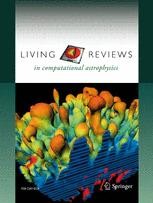Living Reviews in Computational Astrophysics: "Multi-scale simulations of particle acceleration in astrophysical systems"
 Marcowith, A., Ferrand, G., Grech, M. et al. Multi-scale simulations of particle acceleration in astrophysical systems. Living Rev Comput Astrophys 6, 1 (2020). https://doi.org/10.1007/s41115-020-0007-6
Marcowith, A., Ferrand, G., Grech, M. et al. Multi-scale simulations of particle acceleration in astrophysical systems. Living Rev Comput Astrophys 6, 1 (2020). https://doi.org/10.1007/s41115-020-0007-6
Open Access | Review Article
Published: 23 March 2020
Abstract:
This review aims at providing an up-to-date status and a general introduction to the subject of the numerical study of energetic particle acceleration and transport in turbulent astrophysical flows. The subject is also complemented by a short overview of recent progresses obtained in the domain of laser plasma experiments. We review the main physical processes at the heart of the production of a non-thermal distribution in both Newtonian and relativistic astrophysical flows, namely the first and second order Fermi acceleration processes. We also discuss shock drift and surfing acceleration, two processes important in the context of particle injection in shock acceleration. We analyze with some details the particle-in-cell (PIC) approach used to describe particle kinetics. We review the main results obtained with PIC simulations in the recent years concerning particle acceleration at shocks and in reconnection events. The review discusses the solution of Fokker–Planck problems with application to the study of particle acceleration at shocks but also in hot coronal plasmas surrounding compact objects. We continue by considering large scale physics. We describe recent developments in magnetohydrodynamic (MHD) simulations. We give a special emphasis on the way energetic particle dynamics can be coupled to MHD solutions either using a multi-fluid calculation or directly coupling kinetic and fluid calculations. This aspect is mandatory to investigate the acceleration of particles in the deep relativistic regimes to explain the highest cosmic ray energies.
